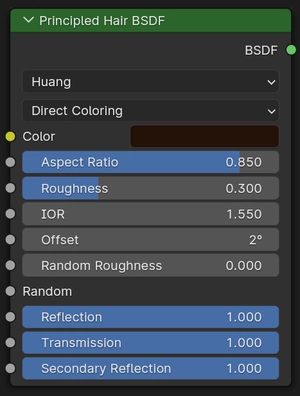Principled Hair BSDF

Cycles Only
The Principled Hair BSDF is a physically-based, easy-to-use shader for rendering hair and fur.
Suggerimento
Realistic hair should have a minimum of variance between each strand.
The shader allows for this by specifying two values, Random Color
and Random Roughness, which remap the specified Melanin/Roughness values to
the range
Ingressi
Comune
- Colore
The RGB color of the strand. Only used in Direct coloring.
Suggerimento
The chosen color is converted to an absorption coefficient with the following formula (section 4.2 of [CBTB16]):
where

Coloring hair using the Direct coloring parametrization. (The numbers on top are the RGB values.)
- Melanin
Absolute quantity of pigment. Range
Suggerimento
This is a linear mapping to the underlying exponential function:

Melanin.
- Melanin Redness
Ratio of pheomelanin to eumelanin. Range
Suggerimento
The ratio formula is:
The resulting quantities are converted (after randomization, if specified) to absorption concentration via the following formula (section 6.1 of [EFHLA11], adjusted for the range

Melanin Redness.
- Tint
Color used for dyeing the hair after applying the melanin pigment. It is not subject to randomization. It can be disabled by setting the color to white.
Suggerimento
This is converted via the Color mapping above and added to the absorption coefficient of the melanin concentration.

Tint, using Melanin 0.1 and the corresponding RGB values.
- Absorption Coefficient
Attenuation coefficient
- IOR
Index of refraction (IOR) defining how much the ray changes direction. At 1.0 rays pass straight through like in a transparent material; higher values give more refraction. Default value is
- Scostamento
Tilts the glint of the hair by increasing the angle of the scales of the hair’s cuticle with respect to the hair shaft. Human hair usually has low values.
- Random Color
For each strand, vary the melanin concentration by
Suggerimento
The melanin concentration is multiplied by

Random Color.
- Random Roughness
For each strand, vary both Roughness values by
Suggerimento
The applied formula is the same one as for Random Color.

Random Roughness.
- Casuale
Random number source. If no node is connected here, it is automatically instanced with the value obtained from .
Chiang Model
The Chiang model is based on a Gaussian distribution with separate roughness along and orthogonal to the hair.
- Roughness
Specify how much the glints are smoothed in the direction of the hair shaft. Too low values will smoothen the hair to the point of looking almost metallic, making glints look like Fireflies; while setting it too high will result in a Lambertian look.

Roughness.
- Radial Roughness
Specify how much the glints are smoothed in the direction of the hair normal. Too low values will concentrate the glint; while setting it too high will spread the light across the width of the strand.
Suggerimento
Mathematically, this parameter is mapped to the logistic distribution’s scale factor

Radial Roughness.
- Coat
Simulate a shiny coat of fur, by reducing the Roughness to the given factor only for the first light bounce (diffuse). Range

Coat.
Huang Model
The Huang model is based on microfacet based reflection and transmission, and supports elliptically shaped hair.
- Aspect Ratio
The ratio of the minor axis to the major axis of an elliptical cross-section. Recommended values are 0.8~1 for Asian hair, 0.65~0.9 for Caucasian hair, 0.5~0.65 for African hair. The major axis is aligned with the curve normal, which can be created with geometry nodes, but is not supported in legacy particle hair.
- Roughness
Microfacet roughness for reflection and transmission.
- Reflection
Optional factor for modulating the first light bounce off the hair surface. The color of this component is always white. Keep this 1.0 for physical correctness.
- Trasmissione
Optional factor for modulating the transmission component. Picks up the color of the pigment inside the hair. Keep this 1.0 for physical correctness.
- Secondary Reflection
Optional factor for modulating the component which is transmitted into the hair, reflected off the backside of the hair and then transmitted out of the hair. This component is oriented approximately around the incoming direction, and picks up the color of the pigment inside the hair. Keep this 1.0 for physical correctness
Proprietà
- Color Parametrization
The shader provides three different ways, or parametrizations, to color the hair strands.
- Direct Coloring:
Choose the desired RGB color and the shader will approximate the necessary absorption coefficient (below).
- Melanin Concentration:
This mode defines the color as the quantity and ratio of the pigments which are commonly found in hair and fur, eumelanin (prevalent in brown-black hair) and pheomelanin (red hair). The quantity is specified in the Melanin input, and the ratio between them in Melanin Redness. Increasing concentrations darken the hair (the following are with Melanin Redness
White (Melanin
Blonde (Melanin
Reddish (Melanin
Brown (Melanin
Black (Melanin
Additionally, the Tint inputs allows to dye the hair with the desired color.
- Absorption Coefficient:
Specifies the attenuation coefficient
Uscite
- BSDF
Standard shader output.
References
This shader is an implementation of the papers by Chiang et al. [CBTB16] and Huang et al. [HHH22].
Chiang, M. J. , Bitterli, B. , Tappan, C. and Burley, B. (2016), A Practical and Controllable Hair and Fur Model for Production Path Tracing. Computer Graphics Forum, 35: 275-283. doi:10.1111/cgf.12830
d’Eon, E. , Francois, G. , Hill, M. , Letteri, J. and Aubry, J. (2011), An Energy‐Conserving Hair Reflectance Model. Computer Graphics Forum, 30: 1181-1187. doi:10.1111/j.1467-8659.2011.01976.x
Huang W., Hullin M.B. Hanika J. (2022), A Microfacet-based Hair Scattering Model. Computer Graphics Forum, 41: 79-91. doi:10.1111/cgf.14588